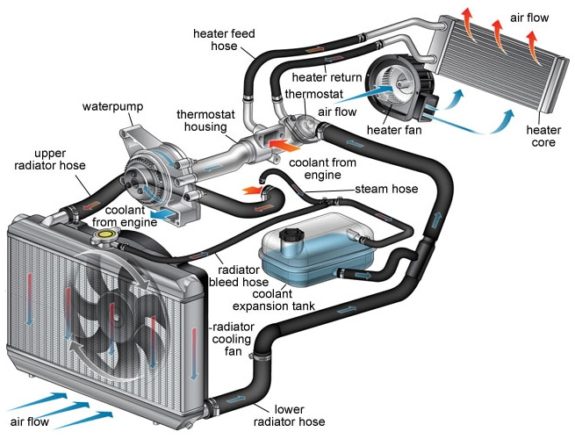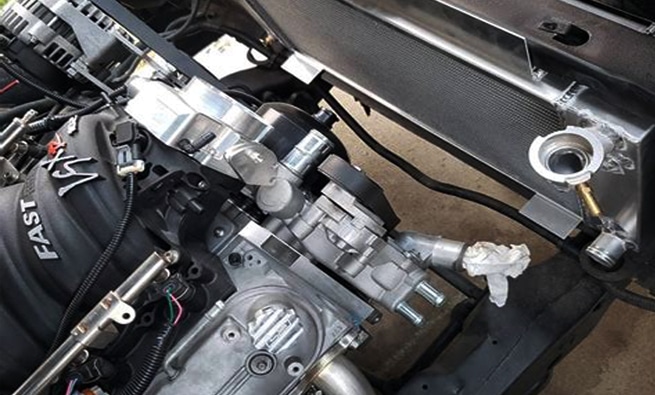Car Radiator Repair Symptoms (7 Failure Signs & How To Fix)
Your car’s engine cooling system plays an important role. Car cooling systems maintain the proper engine temperature for optimum performance. It also provides heat for your car’s interior to keep you warm on cool days.
Often there is no warning that the car’s radiator cooling system is about to malfunction. A catastrophic failure results in a cloud of steam emanating from your hood.
More subtle indications include your temperature gauge rising above normal, indicating engine overheating. There may be a lack of heat in your car on cold days after the engine has reached normal operating temperature.
There are common symptoms and reasons for your car radiator system to fail. This information helps drivers to know what these are and what actually may be needed to make repairs when speaking with a mechanic or even making these repairs on your own. The check engine light may illuminate if your engine is overheating.
Engine coolant flows through the engine, absorbing heat and releases this heat as it flows through the radiator. Low coolant levels may cause engine temperature to rise.
Drivers may notice coolant leaking and pooling under the car’s engine, or a cloud of steam if the coolant leaks onto a hot surface and sweet sickly smell when it evaporates into the air. Any of these indicates a leaking radiator.
Pinholes leaks in the radiator can be accomplished usually by a mechanic. Often the radiator must be removed from the car, cleaned, descaled, and re-soldered to fix the leak.
Occasionally the radiator is rusted beyond car repair and must be replaced. Hoses should be replaced at the same time, and the entire system should be flushed. Also, consider replacement radiators when you a recurrent leak.
Failed water pumps are fairly common. The water pump pushes the coolant through the engine absorbing heat from the engine and back into the radiator where heat is released, cooling the coolant as it returns to the engine. Your engine can overheat fairly quickly.
The internal pressure in the system increases quickly and may cause hot coolant to be released into the overflow container or cause a broken hose, in which case a cloud of steam erupts around your car.
Send your car towed to an engine repair facility, and a mechanic can replace the water pump, flush the system, change the hoses, and add new coolant. Ensure that there is absolutely no debris inside the radiator.
Over time, scale builds up inside the cooling system. The scale can detach from the walls of the system and block cooling tubes in the radiator. If a sufficient number of these tubes become blocked, the radiator cannot do its job to cool the engine coolant.
The flow of coolant is impeded. Regular radiator flushes can solve this problem along with fresh coolant. There are fins connected to the radiator tubes, which help to transfer heat from the radiator to the air as it is drawn through the radiator by the fan.
These fins can be bent, filled with debris from insects, or damaged by accident. In all cases, the efficiency of the radiator to cool the coolant is compromised, which may cause the engine to overheat.
A thorough cleaning of the radiator inside and outside often solves the problem unless the damage was caused by accident. You may need to replace the radiator if it is damaged. Obstruction can also cause leaks from the plastic end tanks. Also, the heat generated when the coolant enters the engine can cause steam.
Modern cars are now equipped with electric fans to cool the engine coolant. The fan draws air through the radiator, which in turn, cools the fluid circulating through the radiator.
On the highway, at higher speeds, the motion of the vehicle forces air through the radiator and cools the radiator. When a car is parked, the air is drawn through the fan shroud and the radiator by the electric fan and cools the system.
A car engine that overheats while the car is parked with the engine running is often due to a failed electric radiator fan. They are easily replaced and relatively inexpensive, provided that no damage was caused to the system due to overheating.
Air occasionally enters the system and actually can block or restrict the coolant from flowing through the system. At the very least, the efficiency is reduced, and your car’s engine may run hot while driving at slow as well as high speeds on the highway. This can cause white smoke generated by the engine.
The coolant system should be bled of air bubbles. In most situations, mechanics may suggest that the cooling system should be flushed to remove the air bubbles and any scale that might also block the system. A new coolant can be added to improve the overall efficiency of your car’s cooling system.
Leaky hoses can gradually lower the coolant level in the system and lowering efficiency. If you suspect leaky hoses, check under your car in the morning for signs of coolant on the ground under the engine. Look at the locations where the hoses connect to the radiator and the engine. Signs of coolant in these areas may also indicate a slow leak.
If the coolant reservoir found on most new cars, is low or dry, add more fluid immediately and then have the hoses checked for leaks and/or replacement. While the hoses are being replaced, drain all of the coolants, have the system flushed and new coolant added. Even if one hose is leaking, have all of them replaced at the same time to avoid future near term problems.
The task of the thermostat is to keep the temperature of the coolant at the prescribed specification for your car’s engine. When a thermostat fails, it can fail fully open, in which case the coolant runs cooler than prescribed.
The thermostat can also be stuck closed, causing the coolant temperature to run far too hot and overheat. A failed thermostat is one of the most common failures and easily replaced by a qualified mechanic.
As we mentioned previously, once the coolant system is opened, all radiator hoses should be checked, the system flushed, and the coolant replaced. If you replace the thermostat and the leaks continue, you should consider to replace your radiator.
7 Most Common Car Radiator Repair Symptoms and How to Fix Them

1. Radiator Leaks
2. Failed Water Pump
3. Obstructions In Cooling System
4. Failing Fan
5. Air In Cooling System
6. Hoses Are Leaking
7. Failed Thermostat (Radiator Repair)
Radiator Repair F.A.Q.
Is it better to repair or to replace a cooling system or car radiator?

Hoses, water pumps, and thermostats can easily be replaced at relatively low cost, including installing new coolant. One of the most expensive components of the cooling system is the auto radiator.
In many cases the radiator can be repaired, however, if it is badly corroded, the fins are broken, and the tubes are blocked, many mechanics recommend that replacement of the radiator should take place.
This approach avoids future near term repairs that may be needed. A special mechanic is needed to repair radiator parts. Depending on the type of damage, a tank repair kit might be needed.
What is the cost to replace a cooling system or radiator?
The cost of car radiator repairs and/or replacement for a standard radiator can cost anywhere from $300 to $1200 depending on the make and model of the vehicle.
Replacing water pumps, hoses, and thermostats cost much less and vary a great deal depending on the make and model. Car radiator replacement or radiator repair cost can be very expensive, especially when the radiator fan is not working properly.
Can you drive with a broken car radiator?

You can drive short distances with a broken radiator, however, watch the temperature gauge very carefully. Running an overheated engine with radiator failure can cause the engine to be damaged beyond plastic repair, including a blown head gasket.
A brand new head gasket with head gasket sealer is used to seal the joint. Drivers should always consider having the car towed to the nearest garage to repair the radiator to avoid spending money on unnecessary repairs.
Do egg shells, epoxy, or pepper fix work to repair a radiator?
None of these solutions stop leaks and should not be added to the cooling system. Temporary solutions using various coolant leak additives can provide a solution to allow your car to be driven to a garage for repairs. Try using a cooling system sealer.
Only use repair kits such as approved radiator stop leaks solutions for small leaks and ensure that the coolant levels are at the proper levels. We suggest to schedule car maintenance and let the experts use professional scan tools to solve any radiator drain issues.
If your failing cooling system is overheating your automobile, schedule a complete auto care check up including hoses, sensor, and leaks.
Car Radiator Repair Summary
The cooling system is an important part of your car’s operation and keeps the engine running efficiently. The components can fail over time and should be replaced immediately to avoid potential damage to the engine.
Replacing a bad or failing radiator is not a simple task; you need special repair tools like pressure testers to get the job done correctly. Leaky hoses, failed water pumps, electric fans, and thermostats, hot air bubbles, radiator leaks, scale buildup can all cause your cooling system to fail and require repairs.
Delaying radiator tank repairs may cause more damage to the engine and more costly repairs. Ask for a copper-brass radiator or aluminum radiators when replacing your current leaking car radiator. After your mechanic successfully fixes your radiator problems make sure you check the brake fluids, radiator fluid, and power steering fluid levels.
The car repair can be as simple as replacing the radiator hose to fix the leak, or you might be required to replace your radiator. Everything that has to do with engine repair is expensive. If you need a tire size for tire repair or replace and automotive advice, please follow our blog.
Last Updated on: October 22, 2024
